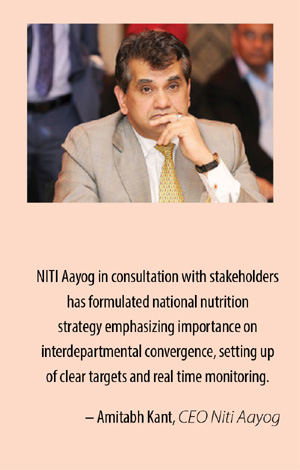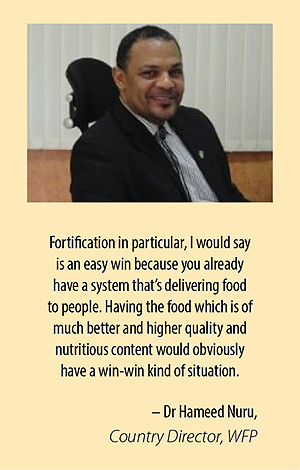
A large share of India’s population suffers from a high incidence of vitamin and mineral deficiencies. Over 70 percent people in India are still consuming less than half of their Recommended Dietary Allowance (RDA) of micronutrients. One third of the two billion people globally that suffer from vitamin and micronutrient deficiencies are in India. This “micronutrients” affects all sections of India’s population–urban and rural, rich and poor, old and young–with women and children most at risk.
Anaemia continues to be a cause of concern. National Family Health Survey (NFHS) 4, 2015-16 showed that 58.4 percent of children in the ages of 6 to 59 months are anaemic, 35.7 percent of children under 5 years are underweight, 53 percent of women in the reproductive age group (15 to 49 years) and 22.7 percent of men in the same age group are anaemic (<13.0 g/dl).

One of the most effective, scalable, affordable, and sustainable ways to address micronutrient deficiencies is fortification of staple foods. Food Fortification refers to adding small amounts of vital micronutrients to foods. It complements diet diversification to help complete a person’s daily nutritional needs. It fills the gap in nutrition in an easy manner without any change in taste, texture, or flavour of food, minimizing the requirement of behavioural change.
Fortification of foods started almost a century ago in 1918. This has led to near eradication of goitre, rickets, beriberi, and pellagra in many countries. Over 130 countries mandated iodised salt, 80 countries have mandated cereal grain (wheat, rice, or maize) fortification and many countries are fortifying milk and edible oils.
Historically, India’s focus has been on addressing Iodine, Vitamin A and Iron deficiencies as Indian diets are commonly deficient in these micronutrients. In India, fortification of Vanaspati with Vitamin A since 1953, and mandatory fortification of salt with iodine since 1962 have been public health successes. However, there has been no program to fortify at scale since then.

Taking the lead on this, the Food Safety and Standards Authority of India (FSSAI) rallied stakeholders across government, industry, food businesses, development partners, scientists, and academia to come together at a National Summit on Food Fortification in October 2016. The formulation of standards on fortification of food in key staples like edible oil, salt, milk, wheat flour and rice, and the launch of the +F logo for fortified foods, has created a rallying point for the industry to adopt fortification, placing it firmly on the national agenda. Voluntary fortification has begun for 5 staples – wheat flour, edible oil, double fortified salt, milk, and rice. Standards for fortified processed foods are under consideration with the Food Authority and will be placed for public comments.
 FSSAI has setup the ‘Food Fortification Resource Centre’ (FFRC) as a nodal point to provide required support to stakeholders. FFRC engages and aligns all stakeholders to build consensus including key government ministries and departments, technical specialists, development partners, food businesses, industry partners, scientists and academia, civil society and consumers. It provides technical and implementation support with respect to technology, premix, equipment procurement, as well as creates awareness among consumers on good nutrition, food safety and fortification. FSSAI has also launched an online portal for knowledge sharing
FSSAI has setup the ‘Food Fortification Resource Centre’ (FFRC) as a nodal point to provide required support to stakeholders. FFRC engages and aligns all stakeholders to build consensus including key government ministries and departments, technical specialists, development partners, food businesses, industry partners, scientists and academia, civil society and consumers. It provides technical and implementation support with respect to technology, premix, equipment procurement, as well as creates awareness among consumers on good nutrition, food safety and fortification. FSSAI has also launched an online portal for knowledge sharing
(www.ffrc.fssai.gov.in).
A comprehensive tool kit including technical handbooks, training manuals, FAQs, list of accredited premix suppliers and equipment manufacturers, list of NABL accredited labs for testing of micronutrients and standardised tender documents have also been developed and are available on the FFRC website.
 FFRC’s key goal is to align supply and demand for fortified food in the market, ensure that food businesses start offering fortified variants of their products, and ensure that consumers find fortified foods easily and at affordable prices. Significant progress has been made for both open market availability and adoption of fortified staples in the government programs at the national and state level. Early adopters of fortification were recognized at FSSAI’s National Summit on “Transforming the Food Safety and Nutrition Landscape” in May 2017. Open market supply of all 5 fortified staples – oil, milk, double fortified salt, wheat flour and rice – is now assured, and is growing month on month.
FFRC’s key goal is to align supply and demand for fortified food in the market, ensure that food businesses start offering fortified variants of their products, and ensure that consumers find fortified foods easily and at affordable prices. Significant progress has been made for both open market availability and adoption of fortified staples in the government programs at the national and state level. Early adopters of fortification were recognized at FSSAI’s National Summit on “Transforming the Food Safety and Nutrition Landscape” in May 2017. Open market supply of all 5 fortified staples – oil, milk, double fortified salt, wheat flour and rice – is now assured, and is growing month on month.
To ensure quality assurance, extensive scaling up and training of laboratory personnel is being undertaken. Regulatory staff is being trained across states in partnership with food safety commissioners. Development partners have been mapped for ground level support and FSSAI/FFRC has reached out to all state/UT governments to appoint a nodal officer to coordinate fortification efforts. Large scale consumer awareness campaigns are being developed and civil society organisations being engaged as partners for dissemination of behaviour change communication.
 As recently as July and August 2017, both the Ministry of Women and Child Development and the Ministry of Human Resource Development have mandated the use of fortified wheat flour, oil and double fortified salt in the Integrated Child Development Scheme (ICDS) and Mid Day Meal Scheme (MDM) respectively, giving a great push to large scale food fortification. Through these schemes, over 250 million beneficiaries including pregnant and lactating mothers and children upto the age of 13 can be reached directly. There is no more compelling argument
As recently as July and August 2017, both the Ministry of Women and Child Development and the Ministry of Human Resource Development have mandated the use of fortified wheat flour, oil and double fortified salt in the Integrated Child Development Scheme (ICDS) and Mid Day Meal Scheme (MDM) respectively, giving a great push to large scale food fortification. Through these schemes, over 250 million beneficiaries including pregnant and lactating mothers and children upto the age of 13 can be reached directly. There is no more compelling argument  for fortification than the nutritional needs and health of these children. Additionally, the Ministry of Food and Civil Supplies has recommended distribution of fortified wheat flour in States where wheat flour is distributed instead of wheat grain, and has also recommended the distribution of fortified edible oil. PDS covers approximately 65% of the population and is hence an important channel for implementing both wheat flour and rice fortification. Adoption of fortified staples will become easier and more accessible once they are widely available at fair price shops across the country.
for fortification than the nutritional needs and health of these children. Additionally, the Ministry of Food and Civil Supplies has recommended distribution of fortified wheat flour in States where wheat flour is distributed instead of wheat grain, and has also recommended the distribution of fortified edible oil. PDS covers approximately 65% of the population and is hence an important channel for implementing both wheat flour and rice fortification. Adoption of fortified staples will become easier and more accessible once they are widely available at fair price shops across the country.
 The organised market and leading brands have responded very favourably to FSSAI’s call to action to come together to address this very important but silent public health issue. With supply now available in the market for all 5 fortified foods, it is important to reach out to consumers and build awareness on fortification, the +F logo and sensitise consumers to the need to adopt fortified food in their daily lives. A joint marketing campaign is being coordinated by FSSAI in partnership with food industries.
The organised market and leading brands have responded very favourably to FSSAI’s call to action to come together to address this very important but silent public health issue. With supply now available in the market for all 5 fortified foods, it is important to reach out to consumers and build awareness on fortification, the +F logo and sensitise consumers to the need to adopt fortified food in their daily lives. A joint marketing campaign is being coordinated by FSSAI in partnership with food industries.
 FSSAI is working closely with industry to ensure wide availability of fortified staples to the public at large, in the shortest possible time. The current status of open market availability of fortified commodities in the market is as shown below –
FSSAI is working closely with industry to ensure wide availability of fortified staples to the public at large, in the shortest possible time. The current status of open market availability of fortified commodities in the market is as shown below –






















